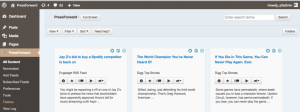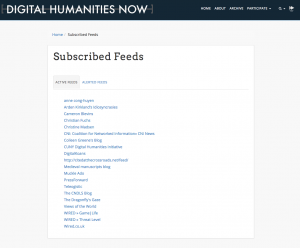One of the first people I ever met at George Mason was Kelly Schrum, the Director of Educational Projects at the Roy Rosenzweig Center for History and New Media (RRCHNM). At the time, I was visiting George Mason as a potential school at which to pursue my Master’s degree in History. After meeting with Dr. Schrum, witnessing her enthusiasm for what she did, and hearing about the diversity of engaging projects being created not only in the Educational Projects Division, but across the entire Center, I thought, “I HAVE to be a part of this!” Three years later, I am excited to finally join the Center in my role as a Digital History Fellow.
Naturally, I was delighted to begin my journey at RRCHNM by spending my first four-week rotation in the Educational Projects Division. While I have had little formal training in classroom-based education (educational theory, lesson plan writing, etc.), I have always been passionate about history education and have held several jobs and internships executing museum-based history education. Also, my interest in using digital tools to help create resources for classroom teachers had been piqued while taking a class called “Teaching and Learning in the Digital Age” as part of George Mason University’s Digital Public Humanities Graduate Certificate (which, coincidentally, is partially administered by the Educational Division at RRCHNM.)
While the Educational Division is somewhat separated from the rest of the Center by a hallway, it was clear right away that it is an integral part of what the Center does. There are multiple different projects that the division juggles at the same time, from creating education websites with partner organizations, to teaching and managing online courses in history and digital tools for classroom teachers and learners of all ages. The Educational Division keeps itself organized with a giant whiteboard, where progress is reviewed in a weekly staff meeting, and with To-Dos, messages and comments through project management software like Basecamp. Because of these organizational methods, it was easy for the DH Fellows to see the status of each project and know what needed to be done next. This allowed us to jump right in and start completing tasks that helped the division move forward on their projects. During what seemed like a short but productive four weeks, we focused on two main projects, Understanding Sacrifice and Eagle Eye Citizen.
Understanding Sacrifice is an ongoing program through the American Battlefield Monument Commission (ABMC) that allows teachers to research a fallen U.S. military hero buried in one of the ABMC cemeteries, write a short biography and eulogy for the fallen hero, travel to the cemetery where that hero is buried, give their eulogy at the hero’s grave, and then write a lesson plan for their students based on what they have learned through the process. This year, the teachers focused on fallen heroes from World War II in the Pacific. Therefore, the cemeteries they visited were in California, Hawaii and the Philippines. For this project, we worked directly with Jennifer Rosenfeld, the Associate Director of Educational Projects.
This project gave me experience doing a wide variety of tasks, as we worked to get this year’s lesson plans, source materials, educational resources, fallen hero profiles, and eulogy videos formatted correctly and uploaded online. Since this project uses a Drupal interface and required us to write basic HTML code, I was thankful for my previous internship at the Smithsonian Institution Archives, where I learned these skills.
Tasks for this project included transcribing audio interviews to be used in some of the teachers’ lesson plans, using YouTube to add closed captions to the eulogy videos and other content videos, inputting and uploading content to the ABMC Education website (images, hero profiles, lesson plans), double checking the sources for each lesson plan, and making sure sources were cited properly and linked to the correct websites. In addition, each online lesson plan also includes a printable PDF version of the lesson plan and applicable handouts. Once these PDFs were created by other GRAs in the division, we were tasked with proofreading them, not only for grammar, but also for content, formatting (spacing, bold, italics, font size, etc.), and consistency between what the teacher originally wrote, what had been added into the website, and what was in the printable PDF. Then we offered suggestions for improvement, which had to be sent back to the teacher for their response and approval before the necessary changes were made on the PDFs and on Drupal.
Out of all the tasks for the ABMC project, I most enjoyed adding the captions to the eulogy videos. First of all, it was a lot like video editing, with which I have previous experience and which I enjoy. Secondly, it allowed me to learn a lot about the fallen heroes–their lives and the sacrifices that they made for our country. Because I know little about WWII in the Pacific, this was very insightful. Thirdly, through the videos of the teachers reading their eulogies at the fallen heroes’ gravesites, I could hear in their voices how much they felt for the the fallen heroes’ families and see how much hard work they had put into recognizing their hero’s sacrifice. This made me want to work even harder to do what I could, to make sure that the teachers’ work in honoring these heroes and teaching their students about them would be ready and available to others.
The second project we worked on is Eagle Eye Citizen. This website was developed by RRCHNM in partnership with the Library of Congress. It teaches civics to middle and high school students by allowing them to solve and create challenges in a game-like environment using primary sources provided by the Library of Congress. As the students solve and create challenges, they earn points, badges, and can even level-up. All the while, they are learning about topics such as voting, political parties, rights and civic responsibilities. The site also offers students a chance to reflect on each challenge at the end, telling how they solved the challenge or giving rationale for their selections when creating a challenge. For this project, we worked primarily with PhD candidate Sara Collini.
When we started our rotation, the site was mostly complete, leading up to soft-launch and then the official launch a few weeks later. Therefore, one of our primary jobs for this project was to “break” the site. We spent hours testing, making sure that all of the interactive elements worked, that students could not move on without completing each task, that the audio clips played, and that all of the links worked. One of the features of Eagle Eye is a “Look Closer” button, which gives students a larger view of each primary source. We checked if that was working. We also changed roles, logging in as a student and then as a teacher, checking to see if teachers could create and manage a class of student users, as well as review their students’ reflections and challenges they had created. We tested the site on different operating systems (Mac vs. PC) and browsers (Chrome, Firefox, Internet Explorer, Safari, etc.) to see how it might respond. Through doing this work, I realized how hard it is to describe with words what, where, why and how something is not working correctly. In the end, I eventually reverted to taking screenshots of issues and then annotating them with text, arrows and circles to point out the irregularities. Finally, at the end of the testing, we even had a chance to create challenges of our own that would be used when the site launches.
Although I only got to spend four weeks in the Education Division, I feel like I did and learned a LOT! Not only did I learn new content (information about ABMC heroes, how a lesson plan is formatted) and skills (how to create bulleted lists in HTML), I also learned about the workflow of a digital history center and how to balance working on different projects at the same time. While I had read a lot about how centers like RRCHNM function (both during the Certificate program and at the beginning of the semester), it has been really beneficial for me to see how the Center’s work is carried out on the ground, on a day-to-day basis, and to be a part of it.
It is also exciting to feel like the small role I played was actually useful for these projects, and that I was doing something that really mattered. Even as we move on to the next division, I am excited to see both of these projects launch and to hear what feedback the division gets from the teachers who are incorporating both projects in their classrooms.


